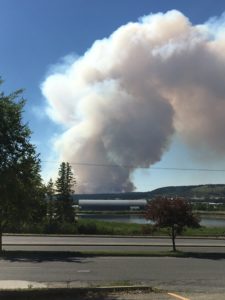ENSU 1000 Giveback Piece
For my final project in Environmental Studies 3991, I chose to investigate an issue in the nearby town of Williams Lake, British Columbia. The assignment involved research about the environmental effects of burning creosote-soaked railway ties.
Below is the link to my completed final project:
ENVS 3991_FinalProject_Donri Helmer_T00599672_2019 April 27.edited
Reflection:
By completing this project, I feel that I became involved in my community on a more intellectual level. I was proud to take an active role in helping local citizens express their views and concerns on a local environmental issue. As I was working on this assignment and interviewing stakeholders, I was also teaching my grade seven class and was able to share some aspects of this project with them. I encouraged them to offer their opinion on the burning of the railway ties and to think about how it might affect the citizens of our neighbours in Williams Lake. By listening to how some of them had not even considered health consequences of burning chemically treated wood, it reminded me of how much I had matured with regard to my comprehension of environmental issues and the well-being of my home town.
While I did not officially present this project to a formal group, I did attend a city council meeting in Williams Lake, where members of the group “Rail Ties Be Wise” plead their case to the community leaders. I was permitted to take photos of the event and speak directly with the project leader. By interviewing a member of the group, who is also a school district trustee for the Cariboo-Chilcotin, I learned additional knowledge about the ways in which this method of disposal could harm various ecosystems, such as forests, animals, local waterways, and economically-dependent crops, many of which were run by local First Nations groups. Learning about this topic through oral story enhanced my appreciation for the topic, as it allowed me to hear and see the compassion that this group had to support their cause. I was fortunate to have been able to choose a local topic to complete the inquiry. I had a connection with Williams Lake, as my children took many lessons and joined the wrestling club there, and my family supported local farmers and merchants of this town and 100 Mile House.
Another reason that I choose to research this particular topic is that my town of 100 Mile House and Williams Lake were both fully evacuated during the 2017 Wildfire season. I saw first-hand the damage that the burning of trees caused to many people with respiratory issues, and how peoples’ businesses and homes were destroyed, and I could only imagine the damage that burning chemicals might cause to humans, crops, and animals. I also became cognizant of the secondary effects of the wildfires, such as flooding and mass wastage. Burning railway ties would only weaken the already compromised landscape.
My initial project proposal was shared with a member of Rail Ties Be Wise, Mary Forbes. After completing an interview with Mary to attain information on the situation in Williams Lake, she was involved in the proofreading and verification of my final project. After attending the aforementioned city council meeting in Williams Lake, I was also able to speak with other members of the Rail Ties Be Wise group and inform them that I was sharing their cause with my grade seven class and Environmental Studies class (ENVS3991) at TRU Open Learning.
PROJECT UPDATE: After speaking with Mary Forbes early in June, she informed me that Rail Ties Be Wise was still waiting to hear the decision from the local council. She will keep me apprised of the rail tie burning situation in Williams Lake, British Columbia.

The above photo shows the start of the Gustafson Lake (human-caused) wildfire which caused the two-week evacuation of 100 Mile House, BC, and surrounding area.
Last week, at a School District 27 Board meeting, I was able to reconnect with the trustee whom I had interviewed. She said that they were still awaiting the results of their request not to burn the railway ties. I am excited to be able to participate in the progress of Rail Ties Be Wise in their fight to protect the environment of Williams Lake.

Photo showing a blanket of smoke in Cache Creek and surrounding area during the 2017 wildfire season.
The fire-damaged hillsides of Ashcroft and Cache Creek BC are prone to yearly flooding, debris flow, and road damage as a result of the wildfire damage.
Burning chemically-treated rail ties will exacerbate the deteriorating air quality in Williams Lake, the landscape of which has also sustained similar damage from the 2017 wildfires.
GIVEBACK COMPONENT: GRADE SEVEN LESSON AND PERSONAL REFLECTION
TRU Verification Form: